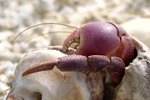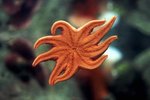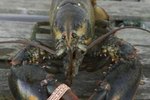
Much of a hermit crab's anatomy is hidden under his characteristic shell. The hard, sometimes ornate shell protects his soft abdomen, which houses his digestive and reproductive systems. The hermit crab creature has several pairs of legs with distinct purposes and eyes that move on stalks.
Cephalothorax, Shell and Exoskeleton
The cephalothorax is the fused head and thorax parts of the hermit crab, similar to those of a spider. Nearly all of the cephalothorax is visible even when the crab is in his shell. The cephalothorax is covered by a hard protective exoskeleton, which the crab sheds in molting. The shell, the most conspicuous part of a hermit crab, is not his own anatomy. He selects an empty one, and as he grows, he chooses larger shells to fit his growing body.
Legs
A hermit crab has five pairs of legs. The first pair is the most noticeable: These are the pincers or claws. The claws are called chelipeds, and both have specific purposes. The left claw is noticeably larger than the right claw. The left claw is used for defense, as well as for climbing and other heavy-duty tasks like protecting the crab while inside the shell. The smaller right claw is used primarily for eating. The next two pair of legs are walking legs and are thinner than the chelipeds. The fourth pair is inconspicuous but important: These two legs hold the shell and helps maneuver it while walking. The final pair are small legs used for maintenance of the shell.
Sensory
On the front of the cephalothorax, in the head region, are the hermit crab's eyes and antennae. The antennae are long, thin feelers the crab uses to feel his surroundings. The second pair, called antennules, are shorter and used for taste and smell. Hermit crab eyes are compound and, instead of being in sockets like a human, they're located on long, mobile stalks that can quickly change direction to allow the crab to see in multiple directions.
Abdomen
Unless you catch a glimpse of your crab outside of his shell, you may never fully get to see his entire abdomen, sometimes called the tail. Unlike the cephalothorax, the abdomen is soft and unprotected. Small appendages on the tip of the abdomen, called uropods, are used to hold onto the shell, much like the smallest pairs of legs. Females have feathery, hairlike appendages along the left side of their abdomens which they attach their eggs to.
References
Resources
Photo Credits
-
Jupiterimages/Photos.com/Getty Images
Writer Bio
With a professional background in gardening, landscapes, pests and natural ecosystems, Jasey Kelly has been sharing her knowledge through writing since 2009 and has served as an expert writer in these fields. Kelly's background also includes childcare, and animal rescue and care.




